When you’re choosing a new multifunction printer (MFP) for your Kansas City office, the spec sheets can start to blur together. Two top contenders you’ll likely see are the Kyocera TASKalfa 4054ci and the HP Color LaserJet Managed MFP E78330. Both are powerful machines, but they are designed with very different priorities in mind.
This isn’t about which one is “better”—it’s about which one is the right tool for your business. Let’s put them head-to-head in a practical comparison to help you understand their unique strengths and find the perfect fit for your team.
Round 1: Which is Faster for Raw Production?
In a busy office, time is a resource you can’t get back. The minutes your team spends waiting for a machine to print or scan add up, impacting productivity and your bottom line. Let’s see how our two contenders stack up when the stopwatch starts.
- Print Speed: When it comes to pure output, the Kyocera TASKalfa 4054ci has a distinct advantage, delivering a brisk 40 pages per minute (ppm). The HP E78330 clocks in at a solid 30 ppm. For an office that frequently handles high-volume print jobs—like large reports or training manuals—that 10-page-per-minute difference is significant and will save your team a lot of time.
- First Page Speed: The Kyocera is also slightly faster off the line for those quick, one-off prints. Its first black-and-white page is out in as little as 5.1 seconds, while the HP takes about 8.9 seconds.
- Scan Speed: Digitizing documents is a critical task. Both machines are incredibly fast, but again, the Kyocera has an edge in raw velocity. When equipped with its top-tier optional document processor, the 4054ci can scan up to an incredible 274 images per minute (ipm) for two-sided documents. The HP E78330 Flow model is also a beast, capturing up to 240 ipm.
The Verdict: For the business where every second counts in raw production speed, the Kyocera 4054ci is the champion. It’s built to minimize waiting and maximize physical output.
Round 2: Who Wins for the Modern Hybrid Office?
Speed is one thing, but how a machine fits into your team’s actual workflow is another. This is where the differences between these two MFPs become crystal clear, especially for Kansas City businesses navigating a hybrid work model.
While both machines can scan to email and network folders, the HP E78330 was built with the cloud-connected office at its core. Its standout feature is the ability to scan files directly to Microsoft® Office 365 and SharePoint. This isn’t a workaround; it’s a native function that can transform your office into a seamless bridge between your physical and digital workspaces. An employee in the office can digitize a contract, and it’s instantly available to a remote team member in your shared SharePoint folder.
Furthermore, the HP “Flow” MFP models (like the E78330z) include a pull-out keyboard. This small feature makes a huge difference in daily workflow, allowing users to quickly and accurately type filenames and client names, which ensures documents are easy to find later. The Flow models also offer intelligent features that automatically crop pages to size and optimize the image, ensuring a perfect digital copy for remote viewers.
The Verdict: For the modern, cloud-centric, hybrid Kansas City business where seamless information sharing is the top priority, the HP E78330 is the clear winner in workflow innovation. It’s designed to connect your people, wherever they work.
Round 3: Which Machine is the High-Volume Workhorse?
Your business needs a machine that not only works fast but also produces professional results and can handle the pressure of your busiest days without constant interruption.
- Print Quality: For businesses that produce high-end marketing materials, every detail matters. The Kyocera 4054ci offers a higher maximum print resolution of up to 4800 x 1200 dpi. The HP E78330 provides an excellent quality of up to 1200 x 1200 dpi. While both produce stunning documents, the higher resolution on the Kyocera may give it an edge for intricate graphics and photo-rich materials where the finest detail is paramount.
- Paper Capacity: This is a measure of a machine’s endurance. The more paper it can hold, the longer it can run without interruption. Both machines start with a similar standard capacity of around 1,150 sheets. However, their maximum capacities are vastly different. The HP can be expanded to hold a total of 3,140 sheets. The Kyocera, on the other hand, can be configured to hold a massive 7,150 sheets. For an extremely high-volume environment, this means the Kyocera can run more than twice as long without needing a refill, saving significant labor time.
The Verdict: For businesses that demand the highest possible print resolution for in-house marketing or need an absolute marathon runner for paper capacity, the Kyocera 4054ci showcases its powerhouse strengths.
Making the Final Decision: Which Tool is Right for Your Team?
So, which machine should you choose? The answer depends entirely on your company’s primary needs.
Choose the Kyocera TASKalfa 4054ci if your priority is high-volume, in-office production.
- You need the fastest possible print speeds to eliminate queues.
- You require the highest possible paper capacity to support long, uninterrupted print jobs.
- You want the highest print resolution for producing top-tier marketing materials in-house.
Choose the HP LaserJet E78330 if your priority is seamless workflow for a hybrid team.
- Your team relies heavily on cloud platforms like Microsoft Office 365 and SharePoint.
- You need to easily bridge the gap between physical paper in the office and your remote workers.
- You value user-friendly features like a pull-out keyboard for better data entry and organization.
